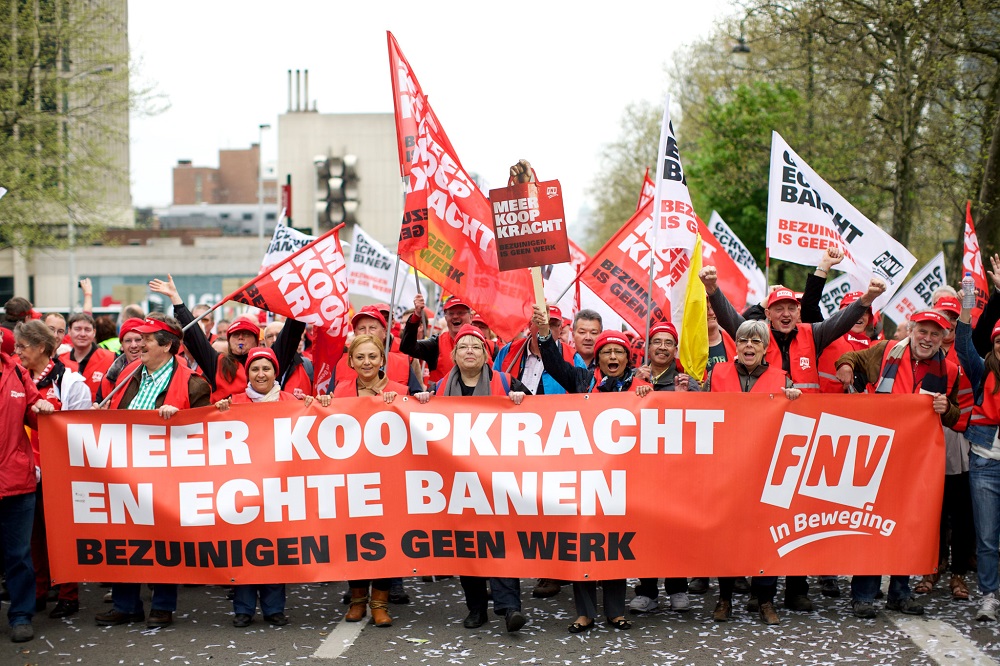Things are going badly for the Dutch trade union movement—and that is because of this
The Dutch trade union movement is continuously losing members. A trend that has lasted for decades. At the end of 2021, it was announced that the membership of the largest trade union, the FNV, was below one million. What is going on? Univers talks about it with Associate Professor Willem Plessen, expert in collective labor law. And with Assistant Professor Michael Bender, specializing in the psychology of inequality.

The waning power of trade unions is not just a problem in the Netherlands, but throughout the Western world, says Associate Professor Willem Plessen. The percentage of workers who are members of unions has declined significantly. “You can see that happening since 1998, the union density of workers in Europe and the United States fell from 40 percent to 31 percent in 2018. And that figure will have dropped even further since then,” Plessen said. “The Netherlands has a union density of 17 percent. FNV membership has pretty much halved in the last ten years.
“In addition, you see that one-third of the members are older than sixty-five, which is huge. Young membership has dropped from 71 percent to 35 percent. The average age at the FNV is fifty. That indicates what the situation will be in ten years.”
High coverage ratio
With a union density of 17 percent, the Netherlands is below the average in Europe, but that is not excessive, Plessen further explains. “France has a union density of only 9.4 percent. Belgium, on the other hand, has a very high union density, but there you only get unemployment benefits if you are a union member.” The associate professor also sees that the declining number of workers that unions represent does not affect the coverage rate of collective labor agreements. That is the proportion of the working population covered by a particular collective labor agreement. “The coverage rate here is still tremendously high. And also in France, collective labor agreements still have a coverage rate of 98 percent.”
This may partially explain the lack of significant wage increases. According to Plessen, the declining number of union members and the broad coverage of the collective labor agreements may allow employers to push their positions in the collective bargaining more easily. “You also see that the union density on the employers’ side in the Netherlands is enormously high, 85 percent. That’s the case in a lot of countries,” Plessen explains.
Personal responsible
But why is it that union membership numbers are declining in times when life is getting more expensive, and wages are lagging behind? This trend has several causes, according to Assistant Professor Michael Bender. “When we think of work, we usually don’t just think of a resource that helps us provide what we need to survive. Work can also be a form of self-expression.”
There is also the so-called “Protestant work ethic”: you are a good citizen if you do your work with diligence. “We see that in countries with this kind of work ethic and with a lot of Calvinist ideas about life in general, there is more individualism. So, you’re responsible for your work that is no other person’s business. It’s quite possible that this attitude comes at the expense of solidarity. The number of union members is therefore declining in such countries as the Netherlands and the United States, but these were not high to begin with.”
Plenty of work to do
Still, many workers would benefit from a strong trade union movement to be able to collectively improve their work situation. Bender: “This applies, on the one hand, to uneducated workers who work, for example, as flash deliverers for Gorillaz or Flink. There is a huge amount of people who can do that kind of work and therefore workers are replaceable, or the working conditions are not ideal. At the other end of the spectrum, there are academics who compete for the very few tenure track positions or have to make do with part-time jobs.”
These are developments that, Bender says, have similarities to principles that were already in place in the nineteenth century. “An important aspect behind the industrial revolution in England in the nineteenth century was that manufacturers could lay off workers whenever they wanted because there were so many of them. Friedrich Engels called this principle the ‘reserve army of labor’ in 1845.”
“Also, people change jobs much more often than they used to,” Bender explains further. “‘Lifelong learning’ comes from that: you have to stay attractive on the job market. You invest in skills and become a product yourself. That means we are increasingly replaceable, and we are automatically more in competition with each other, whether we want to be or not.”
Less clout
It is not all sadness in the union movement according to Plessen. “In the police, the union density is quite decent. In the health care sector, they are well represented and getting things done. There are also strikes going on in the small metal sector at the moment, so there is a sufficiently high union density there to organize that. Still, it’s very difficult for many other sectors. The unions are certainly still getting things done, but the declining union density among workers is not helping.”
Despite the declining membership base, employers still like to make collective bargaining agreements with the unions. Plessen: “You shouldn’t underestimate that because then they can say to their employees, ‘Your representatives agreed to this.’ It provides employers with legitimacy.”
Nevertheless, the unions’ main means of pressure is in jeopardy, Plessen believes. “The ultimate power tool of unions is to go on strike. But there are many sectors where the union density is very low. This makes it difficult for trade unions to say ‘no’ to proposals. They lack the means of power, but they can withdraw from agreements. You increasingly see the FNV not co-signing on collective labor agreements if they don’t think the agreements are good enough.”
No simple solutions
Plessen strongly wonders if it is possible to turn the tide. In any case, he sees that there are no easy solutions. Perhaps a more appealing leadership could put wind in the unions’ sails. “Wim Kok influenced the social debate in his time with the FNV. I don’t see that kind of person at the FNV anymore”. In addition, he sees another possible political solution.
“What the trade union movement may be up against is the ‘generally binding statement.’ Now, it is still the case that a newly concluded collective agreement is declared ‘generally binding.’ In other words, every employee benefits from it. The moment the advantages that unions gain in negotiations only apply to the people who are actually members, the growth might start again,” says Plessen. “But,” he stresses, “it could also mean the end of many collective labor agreements.”
Translated by Language Center, Riet Bettonviel






